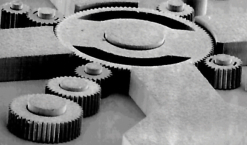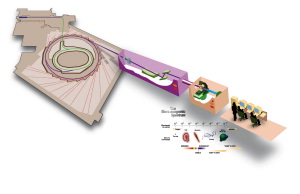
Canadian synchrotron receives $44 million
By DE staff
General government funding R&D UniversityFunding to provide workforce expansion for particle accelerator facility that lets researchers observe matter at the atomic level

The Canadian government announced that it will boost funding for Canadian Light Source (CLS), Canada’s national synchrotron, by $44 million to hire new personnel and generally expand its operating budget. Located at the University of Saskatchewan in Saskatoon, the facility is a 2.9 GeV high-energy particle accelerator that uses electromagnets to accelerate and control a particle beam around a toroid-shaped vacuum tube. As the electrons accelerate, they lose energy and give off photons that can be focused and separated into its component wavelengths, from infra-red to x-ray. Those wavelengths are then tightly focused into beamlines to small laboratories where researchers can use them to observe matter down to the atomic level.

"Synchrotron light is really bright," says Matthew Dalzell, communications coordinator for Canadian Light Source. "In terms of the number of photons, we pack into a square millimeter, light that is billions times brighter than sunlight which is more diffuse. The light is also very tunable. Most of our experiments involve exposes a sample to one particular wavelength of light. By watching what happens – what is absorbed or what is emitted – we can ‘see’ the structure of that material."
According to Dalzell, the research has applications in a wide range of fields, from advanced material science to nanotechnology to the detection of environmental pollutants. The light can also be used for industrial purposes such as etching microscopic patterns for more powerful computer chips, machining micron-scale gears and welding advanced ceramics.

Source: Image courtesy of Dr. Henry Guckel, University of Wisconsin – Madison.
"Using a technique called X-ray lithography, by tuning a very small beam to expose resists or through resists, you can make very small structures on the nano-meter scale," he says. "So things like microchips are all made using X-ray lithography, but you can also machine really small components or research nano-materials such as coatings for aerospace applications or more efficient lubricants or making more absorbent diapers. It all comes down to building a material with a particular set of qualities."
Approximately the size of a football field, Canadian Light Source facility currently has seven unique beamlines and is close to finishing construction on seven more, with plans to build an additional six in the near future. The facility presently employs more than 120 engineers, scientists, technicians and administrators. Administered by the Natural Sciences and Engineering Research Council of Canada (NSERC), the $44 million in new funding, Dalzell says, will be used primarily to hire new personnel to stay competitive and in anticipation of the new beamlines coming online.
www.lightsource.ca
